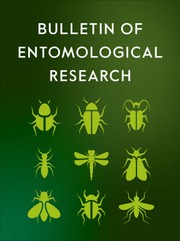No CrossRef data available.
Article contents
The synergistic effect of Metarhizium anisopliae CQMa421 and deltamethrin improved the insecticidal ability against to Bactrocera dorsalis
Published online by Cambridge University Press: 03 July 2025
Abstract
Bactrocera dorsalis (Diptera: Tephritidae) is a highly invasive and destructive quarantine pests worldwide. To improved biological control efficiency, reduce chemical pesticides use, and optimise the application of Metarhizium anisopliae (Hypocreales: Clavicipitaceae) against B. dorsalis. This study evaluated the combined toxicity of M. anisopliae with deltamethrin and chlorpyrifos. The biocompatibility of M. anisopliae CQMa421 with these pesticides was assessed based on spore germination, mycelial growth, and sporulation. Additionally, the effects of combined treatments on detoxification enzyme and related gene expression in B. dorsalis were investigated. The results indicated that the virulence effect of M. anisopliae CQMa421 against B. dorsalis adults was time-dependent and dose-dependent. Deltamethrin showed good compatibility with M. anisopliae CQMa421, achieving 100% mortality at 1 × 10⁸ CFU/mL by 84 hours. Different concentrations of deltamethrin can promote the mycelial growth and sporulation of M. anisopliae CQMa421. The toxicity effect of deltamethrin and chlorpyrifos combined with M. anisopliae CQMa421 on B. dorsalis adults was better than that of single-agent treatment, and the co-toxicity factor of 5 mg/L deltamethrin and 1 × 108 CFU/mL M. anisopliae CQMa421 was 24.81, which synergistically affected on B. dorsalis control. Enzyme activity assays and qRT-PCR results revealed that the combination treatment differentially activated and enhanced the activities of AChE, CarE, GST, CAT, and SOD. Meanwhile, BdCarE was significantly inhibited and upregulating BdGSTD7, BdGSTS1, BdCYP4ae1, BdPOD, BdPOD1, and BdCAT genes. In conclusion, the combination of deltamethrin and M. anisopliae CQMa421 enhanced the insecticidal efficacy against B. dorsalis, significantly affected the activity of related detoxification enzymes. Provided a robust basis for integrating biological and chemical control strategies to manage B. dorsalis more effectively.
Information
- Type
- Research Paper
- Information
- Copyright
- © The Author(s), 2025. Published by Cambridge University Press.
Footnotes
These authors have contributed equally to this work


